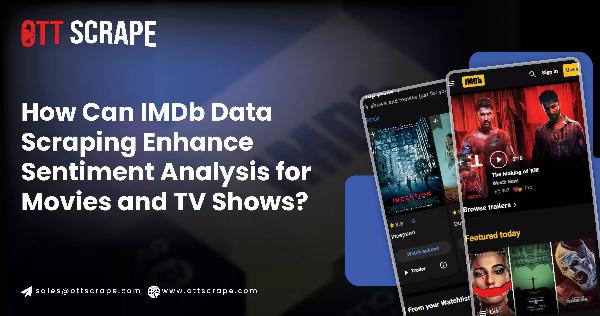How Can IMDb Data Scraping Enhance Sentiment Analysis for Movies and TV Shows?

Strong 8k brings an ultra-HD IPTV experience to your living room and your pocket.
Sentiment Analysis for Movies and TV Shows
Understanding audience reactions is crucial for studios and content creators in the ever-evolving entertainment landscape. One powerful tool for gaining these insights is IMDb data scraping for sentiment analysis. IMDb, the Internet Movie Database, is a leading platform where users share their opinions through reviews and ratings of films and TV shows. By leveraging streaming data scraping, studios can decode audience sentiment, identify recurring themes, and make informed decisions for future projects.
What is IMDb Data Scraping?
What-is-IMDb-Data-Scraping
IMDb data extraction involves the automated collection of data from IMDb's website. This data typically includes user reviews, ratings, movie titles, cast information, and more. Web scraping tools and techniques are employed to gather this information systematically. The process involves several key steps:
1. Selecting the Target Data: Identifying which data points are relevant, such as user reviews, star ratings, release dates, and genres.
2. Choosing the Right Tools: Using web scraping tools and libraries like BeautifulSoup, Scrapy, Selenium, and Puppeteer to extract data.
3. Developing the Scraper: Writing scripts that navigate IMDb's pages, locate the necessary data, and handle dynamic content.
4. Handling Anti-Scraping Measures: Addressing challenges such as CAPTCHA, IP blocking, and rate limiting using rotating proxies and user-agent rotation techniques.
5. Data Cleaning and Storage: Organizing and storing the extracted data in databases or files for further analysis.
Why Use IMDb Data for Sentiment Analysis?
Why-Use-IMDb -Data-for-Sentiment-Analysis
Sentiment analysis involves evaluating and interpreting the emotional tone in textual data, offering valuable insights into the audience's perceptions and reactions. When applied to movies and TV shows, sentiment analysis of user reviews provides a nuanced understanding of how viewers respond to content. Leveraging IMDB data scraping services can uncover information on various film or television series dimensions. Here's a detailed look at how sentiment analysis can be applied:
1. Audience Reactions:
• Emotional Tone: Assess the overall sentiment of reviews to determine whether viewers have positive, negative, or neutral feelings about the film or show.
• Specific Elements: Dive deeper into reactions regarding particular aspects such as plot development, character portrayal, acting performances, direction, and cinematography.
• Viewer Satisfaction: Evaluate how satisfied or dissatisfied audiences are with different content components, providing a comprehensive view of their strengths and weaknesses.
2. Common Themes:
• Recurring Topics: Identify and categorize frequently mentioned themes or issues across various reviews. This could include common praise or criticism about storylines, characters, or technical elements.
• Trend Analysis: Track how themes evolve or vary by genre, director, or actor. This can reveal shifts in audience expectations or preferences.
• Contextual Insights: Understand the context in which specific themes are discussed—whether they relate to societal issues, cultural trends, or the viewers' personal experiences.
3. Performance Metrics:
• Aggregate Ratings: Calculate overall ratings and average scores to gauge the general reception of the film or show. This includes looking at rating distributions and identifying patterns of approval or disapproval.
• Review Volume and Variability: Analyze the volume of reviews and how consistently they reflect the sentiment. A high number of reviews with a consistent sentiment may indicate strong audience reactions.
• Sentiment Trends: Monitor how sentiment changes over time, particularly after significant events such as awards, publicity campaigns, or season finales. This helps in understanding the impact of external factors on audience perceptions.
4. Comparative Analysis:
• Benchmarking: Compare sentiment metrics of a particular film or show against others in the same genre, from the same director, or featuring the same actors. This provides context for evaluating its performance relative to peers.
• Historical Comparison: Assess how sentiment has shifted compared to past works by the same creators or within the same franchise, providing insights into evolving audience expectations.
5. Impact of External Factors:
• Marketing Influence: Examine how marketing strategies, promotional activities, and public relations influence audience sentiment and review patterns.
• Critical Reception: Correlate audience reviews with critic reviews to understand discrepancies or alignments in perception between general viewers and professional critics.
Using these detailed approaches, sentiment analysis using IMDB data scrapers can offer a comprehensive understanding of how movies and TV shows are received, providing actionable insights for filmmakers, marketers, and content creators.
Benefits of IMDb Data Scraping for Sentiment Analysis
Benefits-of-IMDb-Data-Scraping-for-Sentiment-Analysis
IMDb data collection offers valuable insights into audience sentiment by analyzing user reviews and ratings. It helps identify emotional reactions, common themes, and performance metrics, comprehensively understanding how viewers perceive films and TV shows.
1. Understanding Audience Sentiment
Studios and content creators can gauge overall audience sentiment by scraping user reviews and ratings from IMDb. This analysis can reveal whether viewers perceive a film or show positively or negatively. For instance, high ratings and positive reviews often indicate a successful project, while low ratings and negative feedback can signal areas for improvement.
2. Identifying Common Themes
Sentiment analysis can uncover common themes in user feedback. For example, if multiple reviews mention "strong performances" or "weak plot development," it provides valuable insights into what aspects of the content resonate with audiences or need improvement. Identifying these themes helps creators focus on strengths and address weaknesses in future projects.
3. Making Data-Driven Decisions
Studios and creators can use sentiment analysis to make informed decisions about future projects. Understanding audience preferences and reactions allows them to tailor content to meet viewer expectations. Data-driven insights can guide decisions on casting, storylines, marketing strategies, and even sequel developments.
4. Enhancing Marketing Strategies
Analyzing sentiment can also inform marketing strategies. Positive reviews and high ratings can be leveraged in promotional materials, while negative feedback can provide insights into areas that need addressing. Tailoring marketing efforts based on audience sentiment helps create more targeted and effective campaigns.
How to Perform Sentiment Analysis on IMDb Data
How-to-Perform-Sentiment-Analysis-on-IMDb-Data
1. Data Collection
Begin by scraping data from IMDb, focusing on user reviews and ratings. To ensure a representative sample, collect diverse reviews for various movies or TV shows. The data should include review text, star ratings, review dates, and any relevant metadata.
2. Data Preprocessing
Before performing sentiment analysis, preprocess the data to clean and standardize it. This step involves removing irrelevant content, correcting spelling errors, and normalizing text (e.g., converting to lowercase). Tokenization (splitting text into individual words or tokens) and removing stop words (common words with little meaning) are also essential.
3. Sentiment Analysis Techniques
Various techniques can be used for sentiment analysis, including:
• Lexicon-Based Tactics: Using predefined lists of words with positive or negative sentiments to score reviews. Tools like VADER (Valence Aware Dictionary and Sentiment Reasoner) are commonly used.
• Machine Learning Approaches: Training machine learning models on labeled data to classify sentiment. Techniques such as Naive Bayes, Support Vector Machines (SVM), and Deep Learning (e.g., LSTM, BERT) can be applied to predict sentiment from review text.
• Hybrid Approaches: Combining lexicon-based and machine-learning techniques to improve accuracy and handle complex sentiment expressions.
4. Analysis and Visualization
Once sentiment analysis is performed, visualize the results to interpret the data effectively. Tools like Matplotlib, Seaborn, and Plotly can create graphs and charts showing sentiment trends, distribution, and correlations. For instance, a word cloud can highlight frequently mentioned terms in positive or negative reviews, while bar charts display sentiment scores over time.
5. Interpreting Results
Analyze the sentiment results to draw actionable insights. For example, suppose a film consistently receives high ratings and positive feedback for its acting but negative comments about its plot. In that case, it suggests a strong performance by the cast but potential issues with the storyline. Use these insights to inform future content creation and strategic decisions.
Case Studies and Examples
Case-Studies-and-Examples
1. Analyzing Audience Reactions to Blockbusters
Consider a blockbuster film that has generated significant buzz. By scraping IMDb data and performing sentiment analysis, studios can assess whether the audience's excitement matches the reviews. High positive sentiment and enthusiastic feedback can validate the film's success, while mixed or negative sentiment may highlight improvement areas.
2. Understanding Viewer Preferences for TV Series
TV series often have varied viewer reactions across episodes or seasons. Scraping and analyzing IMDb reviews can reveal how audience sentiment changes over time. For instance, if a series starts strong but experiences declining sentiment in later seasons, it may indicate issues with the show's direction or character development.
3. Evaluating Independent Films
Independent films often rely on niche audiences and critical acclaim. By analyzing IMDb reviews and ratings, independent filmmakers can gain insights into their audience's perceptions and refine their marketing strategies. Positive sentiment from a specific demographic can be leveraged to target similar audiences for future projects.
Challenges and Considerations
Challenges-and-Considerations
1. Handling Large Volumes of Data
IMDb hosts vast amounts of data, and scraping large volumes of reviews can be challenging. Efficient data collection and processing techniques are essential to manage this volume and ensure the analysis remains scalable.
2. Dealing with Ambiguity and Sarcasm
Ambiguous language and sarcasm can complicate sentiment analysis. Advanced models and techniques are required to interpret these nuances accurately in reviews.
3. Ensuring Data Privacy and Compliance
When scraping data, compliance with IMDb's terms of service and data privacy regulations is essential. Ensure that data collection practices adhere to legal and ethical standards.
4. Handling Dynamic Content
IMDb's website content may change frequently, affecting the accuracy of scraping tools. Implementing robust scraping strategies and regularly updating scripts can help mitigate this issue.
Conclusion
IMDb data scraping for sentiment analysis provides a powerful means of understanding audience reactions to films and TV shows. By systematically collecting and analyzing user reviews and ratings, studios and content creators can gain valuable insights into audience sentiment, identify common themes, and make data-driven decisions for future projects. Although challenges such as handling large volumes of data and dealing with ambiguous language exist, the benefits of leveraging sentiment analysis far outweigh the difficulties. Embracing these techniques allows a deeper understanding of audience preferences, ultimately leading to more successful and engaging content.
Embrace the potential of OTT Scrape to unlock these insights and stay ahead in the competitive world of streaming!
#IMDbDataScraping
#IMDbDataScrape
#IMDbDataScrape
#IMDbDataCollection
#IMDbDataExtraction
#ExtractIMDbData
#IMDbDataScrapingServices
#WebScrapingIMDbData
Source - https://www.ottscrape.com/imdb-data-scraping-sentiment-analysis.php
Note: IndiBlogHub features both user-submitted and editorial content. We do not verify third-party contributions. Read our Disclaimer and Privacy Policyfor details.


